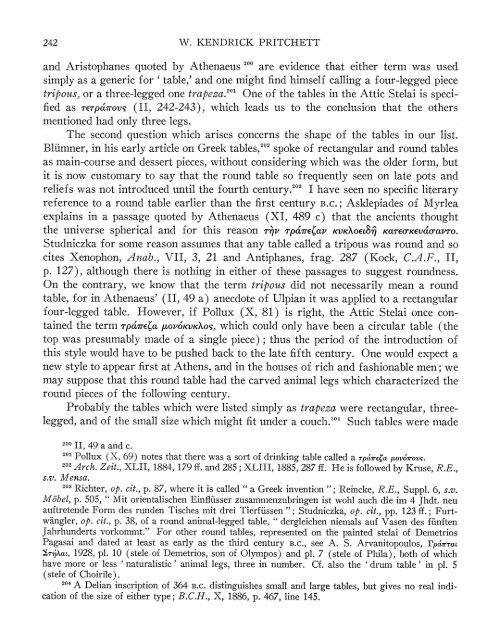the attic stelai - The American School of Classical Studies at Athens
the attic stelai - The American School of Classical Studies at Athens
the attic stelai - The American School of Classical Studies at Athens
Create successful ePaper yourself
Turn your PDF publications into a flip-book with our unique Google optimized e-Paper software.
242 W. KENDRICK PRITCHETT<br />
and Aristophanes quoted by A<strong>the</strong>naeus 200 are evidence th<strong>at</strong> ei<strong>the</strong>r term was used<br />
simply as a generic for 'table,' and one might find himself calling a four-legged piece<br />
tripous, or a three-legged one trapeza.201 One <strong>of</strong> <strong>the</strong> tables in <strong>the</strong> Attic Stelai is specified<br />
as TETpaiTrovS (II, 242-243), which leads us to <strong>the</strong> conclusion th<strong>at</strong> <strong>the</strong> o<strong>the</strong>rs<br />
mentioned had only three legs.<br />
<strong>The</strong> second question which arises concerns <strong>the</strong> shape <strong>of</strong> <strong>the</strong> tables in our list.<br />
Bliumner, in his early article on Greek tables,202 spoke <strong>of</strong> rectangular and round tables<br />
as main-course and dessert pieces, without considering which was <strong>the</strong> older form, but<br />
it is now customary to say th<strong>at</strong> <strong>the</strong> round table so frequently seen on l<strong>at</strong>e pots and<br />
reliefs was not introduced until <strong>the</strong> fourth century.203 I have seen no specific literary<br />
reference to a round table earlier than <strong>the</strong> first century B.C.; Asklepiades <strong>of</strong> Myrlea<br />
explains in a passage quoted by A<strong>the</strong>naeus (XI, 489 c) th<strong>at</strong> <strong>the</strong> ancients thought<br />
<strong>the</strong> universe spherical and for this reason T'v TpaLTE;c KVKXOEL& KaTEOKEvao-aVrO.<br />
Studniczka for some reason assumes th<strong>at</strong> any table called a tripous was round and so<br />
cites Xenophon, Anab., VII, 3, 21 and Antiphanes, frag. 287 (Kock, C.A.F., II,<br />
p. 127), although <strong>the</strong>re is nothing in ei<strong>the</strong>r <strong>of</strong> <strong>the</strong>se passages to suggest roundness.<br />
On <strong>the</strong> contrary, we know th<strong>at</strong> <strong>the</strong> term tripous did not necessarily mean a round<br />
table, for in A<strong>the</strong>naeus' (II, 49 a) anecdote <strong>of</strong> Ulpian it was applied to a rectangular<br />
four-legged table. However, if Pollux (X, 81) is right, <strong>the</strong> Attic Stelai once contained<br />
<strong>the</strong> term Tpa'rEZa /LOVoKVKXOS, which could only have been a circular table (<strong>the</strong><br />
top was presumably made <strong>of</strong> a single piece); thus <strong>the</strong> period <strong>of</strong> <strong>the</strong> introduction <strong>of</strong><br />
this style would have to be pushed back to <strong>the</strong> l<strong>at</strong>e fifth century. One would expect a<br />
new style to appear first <strong>at</strong> A<strong>the</strong>ns, and in <strong>the</strong> houses <strong>of</strong> rich and fashionable men; we<br />
may suppose th<strong>at</strong> this round table had <strong>the</strong> carved animal legs which characterized <strong>the</strong><br />
round pieces <strong>of</strong> <strong>the</strong> following century.<br />
Probably <strong>the</strong> tables which were listed simply as trapeza were rectangular, threelegged,<br />
and <strong>of</strong> <strong>the</strong> small size which might fit under a couch."04 Such tables were made<br />
200 II, 49 a and c.<br />
201<br />
Pollux (X, 69) notes th<strong>at</strong> <strong>the</strong>re was a sort <strong>of</strong> drinking table called a TpawrEca 4Lovo7roVs.<br />
202<br />
Arch. Zeit., XLII, 1884, 179 if. and 285; XLIII, 1885, 287 if. He is followed by Kruse, R.E.,<br />
s.v. Mensa.<br />
203<br />
Richter, op. cit., p. 87, where it is called " a Greek invention "; Reincke, R.E., Suppl. 6, s.v.<br />
Mabel, p. 505, " Mit orientalischen Einfluisser zusammenzubringen ist wohl auch die im 4 Jhdt. neu<br />
auftretende Form des runden Tisches mit drei Tierfiissen "; Studniczka, op. cit., pp. 123 ff.; Furtwangler,<br />
op. cit., p. 38, <strong>of</strong> a round animal-legged table, " dergleichen niemals auf Vasen des fiinften<br />
Jahrhunderts vorkommt." For o<strong>the</strong>r round tables, represented on <strong>the</strong> painted <strong>stelai</strong> <strong>of</strong> Demetrios<br />
Pagasai and d<strong>at</strong>ed <strong>at</strong> least as early as <strong>the</strong> third century B.C., see A. S. Arvanitopoulos, rpapraL<br />
YrTu<strong>at</strong>, 1928, pl. 10 (stele <strong>of</strong> Demetrios, son <strong>of</strong> Olympos) and pl. 7 (stele <strong>of</strong> Phila), both <strong>of</strong> which<br />
have more or less 'n<strong>at</strong>uralistic' animal legs, three in number. Cf. also <strong>the</strong> 'drum table' in pl. 5<br />
(stele <strong>of</strong> Choirile).<br />
204 A Delian inscription <strong>of</strong> 364 B.C. distinguishes small and large tables, but gives no real indic<strong>at</strong>ion<br />
<strong>of</strong> <strong>the</strong> size <strong>of</strong> ei<strong>the</strong>r type; B.C.H., X, 1886, p. 467, line 145.
















